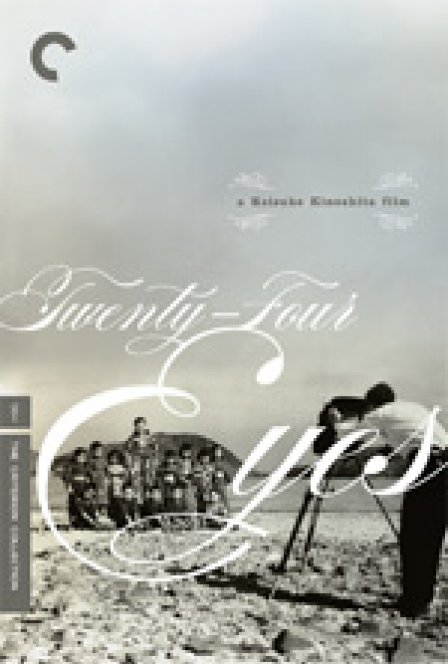It's difficult sometimes to put films into a historical context, especially when watching foreign movies. Although clothes may be outmoded and special effects are archaic, it's easy to lose oneself in the epoch taking place inside the film. Isn’t that the sign of a good movie? No one wants to watch a period piece and remain rooted in the present day. Unwanted anachronisms are a sign of shoddy filmmaking.
When one looks at the film with a modern mindset, Keisuke Kinoshita’s gentle Twenty-Four Eyes is a multi-year chronicle of the relationship between a schoolteacher and her 12 pupils over a few decades. Set on the remote island of Shodoshima in Japan’s Inland Sea, Twenty-Four Eyes begins as new teacher Hiskao Oishi (Hideko Takamine) arrives to teach a class of first-graders and ends years later when Oishi reunites with many of her now-grown pupils following World War II. But the film, produced in 1954, takes on a very different meaning when viewed with a proper historical perspective.
At the time of release, Japan had been out of Allied rule for only three years. War, guilt, and the shame of defeat still stung the country. According to film critic Audie Bock, the film “was seen as a celebration of the positive family values and scenic beauty that defeat and privation could not destroy.” Twenty-Four Eyes was a breath of fresh air for the Japanese. The film allowed the country a therapeutic opportunity to focus on positive forces: childhood, laughter, and happiness, rather than the oppressive barrage of misinformation that they had been fed during the war years.
The film takes its time to progress towards the inevitability of war. Oishi, so earnest yet shunned by the local population for being a modern woman (wearing a skirt and riding a bike), attempts to tame her unruly class via games and songs. But the parents refuse to allow her a foothold in the community until a freak accident prevents Oishi from finishing out the year. Devastated, the children make a long walk to her house. Once the parents realize how much the children value Oishi, it's too late. Flash-forward five years and Oishi is again the teacher, as her old students enter sixth grade. This is when the real drama takes place. Japan is on the brink of war and Oishi tries her hardest to quell the nationalist spirit of her male students (the Army conscripted boys at 14) and to prevent her female students to slip into meaningless existences. When one of her girls is sent away to become a waitress, it's almost too much for Oishi to bear.
One of the greatest strengths of Twenty-Four Eyes is the beautiful locations of its settings. In Shodoshima, the mountains meet the sea. The children play and sing under falling cherry blossoms. It is the idyllic Japan that existed before the war and the Atomic bomb tore it apart. Since the movie is set in such a remote locale, it takes years until the signs of war touch its community. When Oishi is first accused of being a Red sympathizer, it comes as a shock because nothing from the outside world seems capable of bursting their bubble of fishing boats, rice farms, and the wonder that comes from seeing a woman on a bicycle.
However, the film itself is far from perfect. Its pacing is lopsided, not all of the pupils are well-developed, and at times they are indistinguishable from one another. The tragic deaths of three major characters happen one after another, allowing little time to process the depths of these losses or the affect they have on Oishi. When the film ambles to its final emotional pay-off -- and it’s a good one -- what should have been a moment of fantastic emotionalism is muted by all the mawkish crescendos that preceded it.
If we look at Twenty-Four Eyes today, we see a simple anti-war tale where anything is preferable to the destruction wrought by war. There is a lot of crying in this film, both by Oishi and her pupils; a lot more emotion is portrayed here than the typical Japanese film of the early 1950s. But does it lose some effect years later? Ostensibly, yes. It's impossible to understand the film with the same perspective of those living in Japan at the time of its release, but Twenty-Four Eyes' reflection of tranquility, then hardship, and finally redemption in a war-torn country remains relevant.

